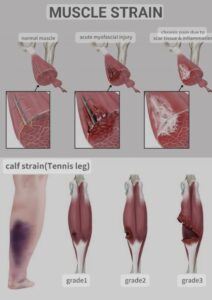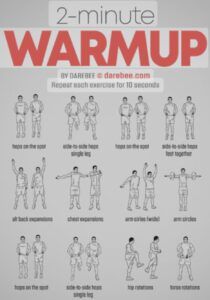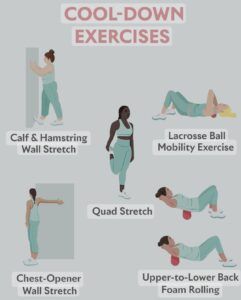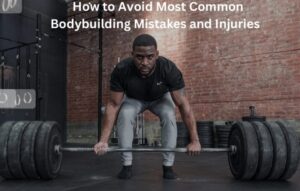Training at high volume and intensity can sometimes lead to injury which is detrimental to reaching out fitness goals.
Whether you are a fitess fanatic or just starting out it is essential to know how to avoid common bodybuilding mistakes and inuries.
In this article i will tell you the most common bodybuilding mistakes and injuries and give you advice on how to prevent them. Leading you towards a safe and injury-free journey to building muscle and strength.
Common Bodybuilding Mistakes
1. Neglecting Warm-Up and Cool-Down
Warming up is essential to help prevent strains and injuries, It increase blood flow to your muscles and prepares them for an intense workout. Spend 5-10 minutes doing light cardio and dynamic stretches.
After your workout, cool down with static stretches to improve flexibility and reduce muscle soreness.
2. Ego Lifting
Tying to lift too heavy, too quick. Progressive overload is key to building muscle, but rushing it can lead to injuries. You should increase the weight or intensity of your workouts gradually to give your muscles time to adapt.
3. Using Incorrect Form
One of the most common mistakes in bodybuilding is sacrificing form for heavier weights. Poor form can lead to injuries and hinder muscle growth. You should focus on perfecting your technique before increasing the weight.
4. Overtraining and Not Allowing Recovery Time
Rest days are essential to allow your muscles to repair and grow stronger. Avoid working the same muscle group intensely within 72 hours to ensure your muscles have enough time to recover.
5. Ignoring Mobility and Flexibility
Mobility and flexibility are often overlooked but are essential for preventing injuries. Yoga is excellent to help maintain and improve joint health and flexibility.
Common Injuries in Bodybuilding

1. Muscle Strains and Tears
Lifting too heavy and poor form can result in muscle strains or tears. You should warm-up and cool down for every workout, use correct form, and avoid lifting weights thats are too heavy.
2. Back Injuries
Back injuries are one of the most common injuries in bodybuilding. The main cause of back injuries is poor form during exercises like deadlifts and squats.It is importabt to protect your back by engaging your core, keeping your spine neutral, and starting with lighter weights.
3. Joint Issues
Joints injuries are very common in bodybuilding, especially the knee and rotator cuff joints. You should protect your joints by maintaining good form and not lifting too heavy, too quick.
How to Avoid Bodybuilding Injuries
It is impossible to completely erase the risk of injuries from bodybuilding, but there are things you can do reduce them.
- Warm-up and cool-down before every workout.
- Use proper form and technique.
- Regularly perform mobility and flexibility exercises.
- Allow enough recovery time between workouts.
- Use progressive overload and don’t go too heavy, too quick.
- Use a well-rounded workout routine that targets diverse muscle groups for balanced development.
- Ensure proper nutrition
Warming Up and Cooling Down

Warming up and cooling down are both essential if you want to prevent injuries when working out. You should warm up before performing and physical activity to increase blood flow to your muscles and cool down after any physical activity to reduce muscle soreness and reduce the risk of injuries.
Warming Up
Before beginning any workout or sporting activity you should spend 5-10 minutes doing light cardio and dynamic stretches.
Dynamic stretches are essential to warm up your body and increase blood flow to your muscles, preparing them for physical activity. Here are 10 dynamic stretches I perform regularly in my warm up routines.
- Leg Swings: Stand next to a wall or support, and swing one leg forward and backward, then side to side, to increase hip mobility.
- Arm Circles: Rotate your arms in small and large circles to loosen shoulder joints and muscles.
- Hip Circles: Rotate your hips in circles to improve hip mobility and flexibility.
- High Knees: Lift your knees as high as possible to warm up your lower body and core.
- Butt Kicks: Kick your heels toward your glutes to stretch your quads and hamstrings.
- Walking Lunges: Take large steps forward and perform lunges to activate leg muscles and improve flexibility.
- Hip Flexor Stretch: Take a step forward and lower your hips to stretch the hip flexors while keeping your back leg straight.
- Ankle Circles: Rotate your ankles in circles to improve ankle mobility and reduce the risk of ankle injuries.
- Torso Twists: Stand with your feet hip-width apart and twist your torso from side to side to warm up your core and spine.
- Arm Swings: Swing your arms forward and backward to engage your shoulders and upper body.
It is important to perform these stretches with control and gradually increase the range of motion as you warm up.
You should adapt your warm-up to the specific activity you are about to perform. For example if you was training upper body you should focus mainly on upper body stretches and if you was training lower body you should focus mainly on lower body stretches.
Cooling Down
Cooling down after physical activity is important to reduce the risk of injury and promote recovery. Here are 10 stretches I perform regularly in my cool down routines.
- Standing Quadriceps Stretch: Stand on one leg and pull your other heel towards your glutes to stretch your quadriceps.
- Hamstring Stretch: Sit with one leg extended and the other leg bent so the sole of your foot touches your inner thigh. Reach forward to stretch your hamstrings.
- Calf Stretch: Stand facing a wall with one foot forward and one foot back. Lean into the wall to stretch your calf muscles.
- Hip Flexor Stretch: Kneel with one foot forward and the other knee on the ground. Gently push your hips forward to stretch the hip flexors.
- Butterfly Stretch: Sit with your feet together, and gently press your knees toward the ground to stretch your inner thighs.
- Child’s Pose: Kneel on the ground and sit back on your heels while reaching your arms forward to stretch your back and shoulders.
- Cat-Cow Stretch: Start on your hands and knees. Arch your back upward (cat) and then downward (cow) to stretch your spine.
- Triceps Stretch: Raise one arm overhead and bend your elbow, then use your opposite hand to gently push your elbow to stretch the triceps.
- Shoulder Stretch: Cross one arm in front of your chest and use the opposite hand to gently pull it closer to your body.
- Neck Stretch: Gently tilt your head from side to side and forward and backward to stretch your neck muscles.
Hold each stretch for 15-30 seconds whilst remaining relaxed and focusing on deep breathing. Cooling down with these stretches can help reduce muscle soreness and improve flexibility.

Diet, Nutrition and Supplementation
Training is a key aspect to both weight loss and muscle gain, but it is pointless without combining is with good diet and nutrition. By combining training with balanced diet and nutrition, your results will be incredible.
Here are some articles about what foods to eat or avoid when trying to gain muscle or lose weight:
- Delicious Smoothies to Boost Your Weight Loss Journey
- Fuelling Your Gains: The Ultimate Guide to Nutrition for Lean Muscle Building
- Foods to Avoid When Trying to Lose Belly Fat
There are also various different supplements on the market that can aid muscle gain and weight loss if you hit a plateau or feel like you need a bit of extra help. However, be careful when choosing which supplement to use, as a lot of them do not work, and could cause harm.
To help you to choose the best supplement to reach your goals, I have done a lot of research and testing on a number of supplements myself to find out which supplements are safest and work best.
Here are some articles on supplements that I have written to help you achieve your goals:
- Top Supplements for Building Lean Muscle.
- Benefits and Side Effects of Creatine Monohydrate
- Top 5 Fat Burning Supplements to Boost Your Weight Loss Journey
- The Ultimate Guide to Choosing the Best Protein Powders for Weight Loss
- How to Choose the Best Supplement for Weight Loss
If you combine training, diet and supplementation into either a muscle gaining program or a weight loss program, you cannot fail to reach you training goals.
Conclusion: Living An Injury Free Life
Bodybuilding is an excellent way to increase strength, muscle mass and general fitness, but it is essential to prioritize injury prevention.
By avoiding common bodybuilding mistakes, warming up and cooling down and focusing on proper technique, you can help reduce the risk of injury. Bodybuilding is not just about lifting heavy weights, it is about lifting safely and effectively to achieve your goals.
Feel free to leave any questions or comments below, and share this article with others who share your passion for bodybuilding. Stay injury-free and keep pushing toward your fitness goals.
